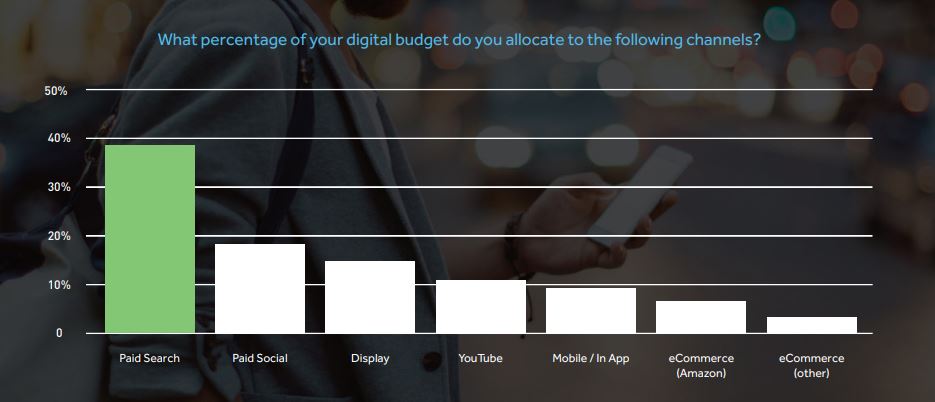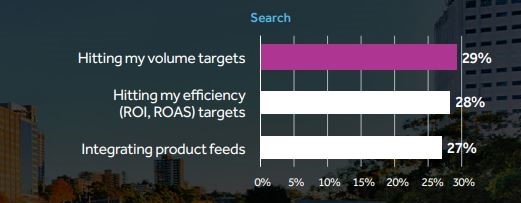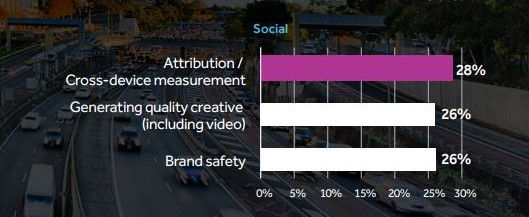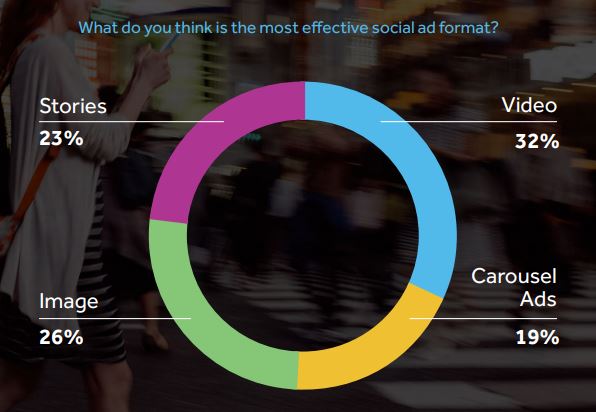A recent study by Marin Software, titled
The State of Digital Advertising 2019, looks at some important trends in digital marketing.
“Although advertisers continue to pursue the long standing goals of driving brand awareness and growing their business, they face constant challenges: new and evolving technologies, knowledge gaps, gaining a full view of the customer journey — and that’s just the tip of the marketing iceberg,” the study reports.
Interested in finding out more? Then read on!
What do digital advertisers care about most?
As with all advertisers — online
and offline — increasing brand awareness is the number one strategic goal. According to the study, 25% of respondents listed that as their top priority.
The next most important strategic element for digital advertisers is enhancing the customer experience (with 22%) and embracing omnichannel marketing (at 20%).
When it comes to tactical goals though, the majority of respondents (at 20%) said that delivering personalisation was the number one goal.
But it is clear that
tactical goals are a little more tightly grouped than
strategic goals. Embracing social media, optimising paid search and campaign management were all tied for second place at 19%.

In 2019, and looking forward to 2020, digital marketers will need to deliver on both strategic and tactical goals to get the better of their competitors.
How are ad budgets spent?
Wondering where most digital marketers are allocating their hard, fought-for funding? Well, according to the study, paid search still dominates, but there are other channels fighting it out to take their fair share.
Paid search accounted for just under 40% of the majority of respondents digital budgets, with paid-for social posts, display ads and YouTube ads coming in under the 20% mark. Finally, mobile and in-app spend, e-commerce on Amazon and other e-commerce spend made up under 10% of the budgets.

When it comes to paid social media, Facebook has long dominated the budget. However, as Instagram continues to gain traction, digital marketers are starting to wonder if their Instagram budget will come at the expense of Facebook.
According to the study, 61% of respondents said they
did expect their 2019 Instagram budget to increase, but only 33% of respondents thought that extra budget would come out of the Facebook budget.
Sixty-seven percent of respondents thought that their increased Insta-budget would come from incremental increases.
 So, die-hard Facebook advertisers — fear not! Instagram is not going to kill your Facebook spend.
So, die-hard Facebook advertisers — fear not! Instagram is not going to kill your Facebook spend.
What challenges are advertisers facing?
The world of advertising is certainly not short of issues, and the study shows that each digital channel brings its own set of problems with it. It is evident that digital advertisers have very different goals and expectations for each channel they use.
Search engine marketing (SEM)
SEM (often referred to as ‘search marketing’) covers practices of search engine optimisation and utilising paid search listings on search engines.
When it comes to SEM, marketers major challenges were all pretty close:
- Hitting volume targets (at 29%)
- Hitting ROI targets (at 28%)
- Integrating product feeds (at 27%)

Social media marketing
Social media marketing covers all content and branded marketing on various social media platforms, including Facebook, Twitter, Instagram and YouTube.
When it comes to dealing with these social channels, marketers are facing issues with attribution and measuring success across devices.
Creating quality content is also an issue, as audiences demand high-quality and relevant content — but each social channel has specific types of content that perform best. This leaves marketers stuck trying to create top quality photos, videos and written content all the time.
Finally, brand safety is an issue on social media as it is almost impossible to know exactly where your content will appear since ad placement is in the hands of algorithms belonging to companies like Google, which owns YouTube and Facebook.

Amazon
With regards to Amazon, digital marketers are struggling to find their feet. But since the company is fairly new to Adland, it is no surprise that there is a substantial knowledge gap when it comes to knowing and understanding how to run successful campaigns.
The study revealed that collecting audience data was simple enough, but
leveraging that information is the biggest struggle advertisers face.
Understanding
exactly how Amazon’s advertising techniques work also proved to be a common issue faced, along with the performance of Amazon ads compared to other forms of digital advertising.

Who can we trust?
With numerous regulations coming into place regarding consumer privacy (
think GDPR and, in South Africa, POPI) digital marketing is obviously facing a crisis regarding
trust and
data privacy.
So, when you have to share content online and make use of online publishers — who can you trust?
According to the study, Google has been ranked as the most trusted publishing platform, with YouTube and Amazon a close second and third place respectively.

And what goes hand-in-hand with consumer trust?
Data privacy! According to the study, data privacy, ad blocking and information tracking restrictions ?— along with video advertising ?— are the trends that will impact business the most throughout 2019.

What’s trending in 2019?
As new technologies develop — along with consumer demands — digital marketers are having to keep up with the latest trends to ensure they stay ahead of the curve.
So, what are the 2019 digital marketers trends?
Responsive search ads
Google’s new offering, responsive search ads, allow you to create an ad that adapts to show more text — and more relevant messages — to your customers. Basically, it’s AB testing that Google does for you!
According to Google, you enter multiple headlines and descriptions when creating the ad and, over time, Google Ads will automatically test out different combinations and learn which ones perform best.
“By adapting your ad’s content to more closely match potential customers’ search terms, responsive search ads may improve your campaign’s performance.”
Shoppable ads
Another new feature from Google Ads is shoppable ads. These ads help target shoppers that are in the ‘inspiration’ phase of shopping.
When users search for something on Google Images, ‘sponsored’ images will also appear in the results which link directly to products available for sale.
Pretty cool, huh?
Video
Finally, video on social media is continuing to grow in strength — it remains the most popular social content format.
With Facebook, Instagram, YouTube and other video-focussed social platforms continuing to attract audiences, it would make sense for digital advertisers to focus their efforts on content that audiences
want to see. And what do they want to see? Videos —
a lot of videos.
 What trends do you think we can expect to see in digital advertising for 2020 and beyond? Share you thoughts with us in the comments section below.
What trends do you think we can expect to see in digital advertising for 2020 and beyond? Share you thoughts with us in the comments section below.
Along with shoppable and responsive search ads, Google has some pretty nifty ideas about when and how to reach consumers and serve them relevant content. Find out more in our article, What on earth is micro-moment marketing?